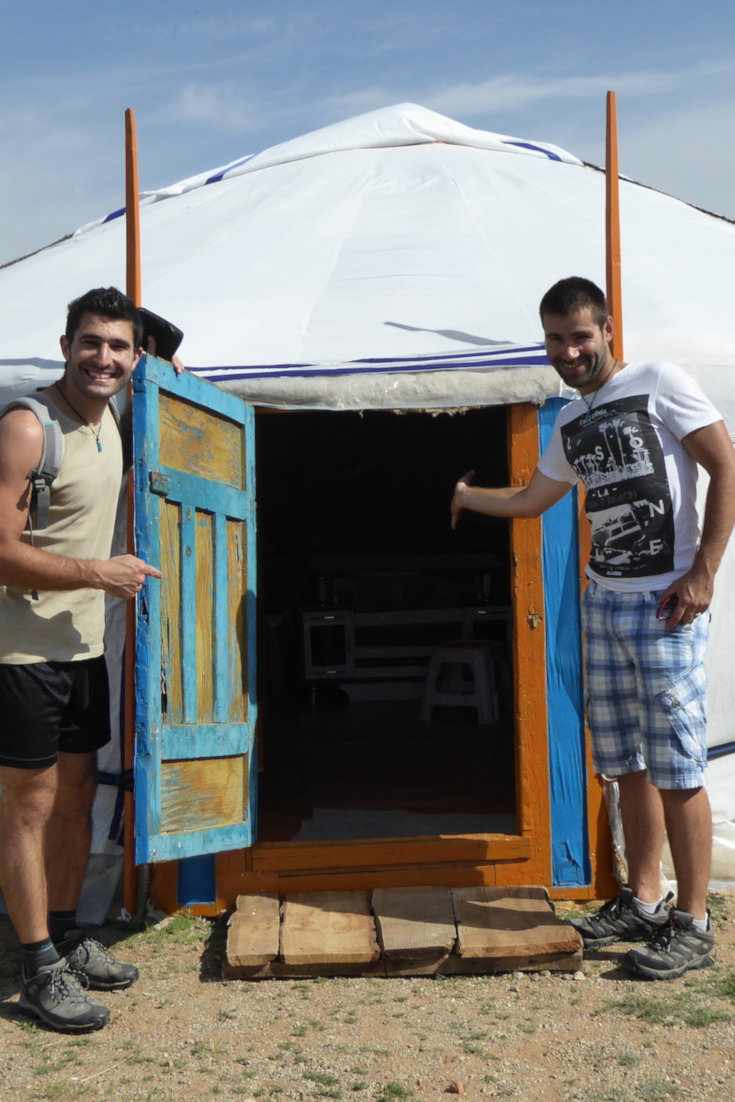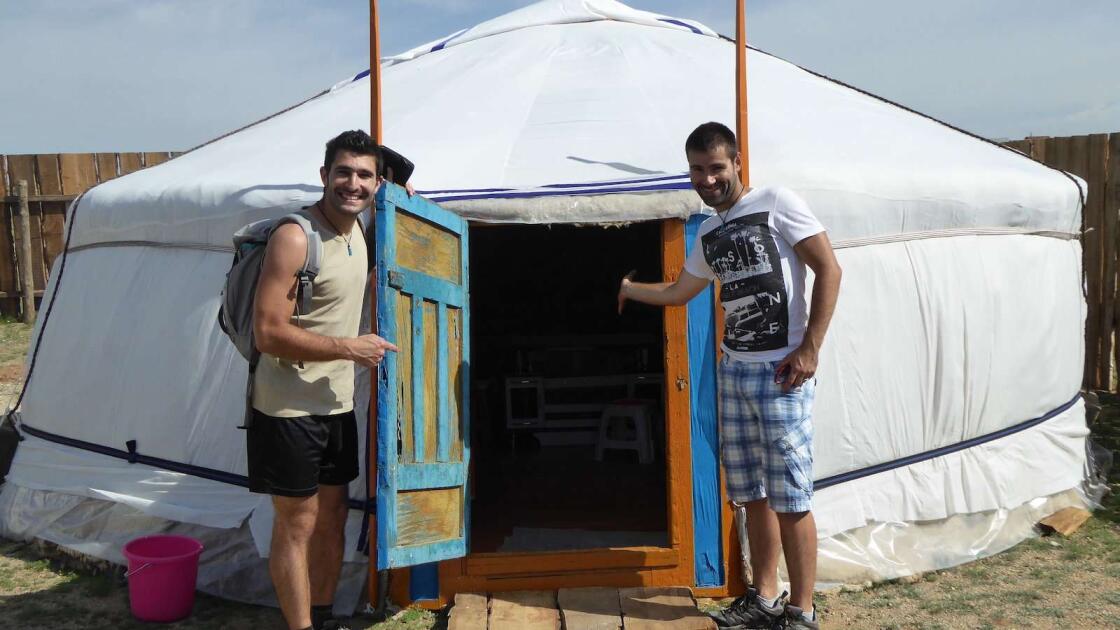Our gay travel guide to Mongolia sets out the best gay friendly hotels to stay in, the gay bars/clubs to check out, practical safety tips for LGBTQ travelers, and more.
When asked which is our favorite place in the world we've been to, Mongolia is one place we both agree is truly remarkable!
We visited Mongolia after our Trans Siberian railway adventure and ended up staying for a month. We didn't expect to, but the landscapes in the Gobi Desert and the nomadic life along the Mongolian steppe just blew our minds. We loved it! Yes, it's roughing it slightly as luxuries are scarce out here, but this is one cultural adventure you won't forget in a hurry.

When it comes to gay travel, it's fair to say that Mongolia is not the #1 place that comes to mind! This is a far cry from the Circuit parties of Barcelona or the wild gay scene of Fort Lauderdale. Mongolia is more of a place to come to be awed by nature; a photographer's paradise!
However, we still think it's a place other gay travelers should experience. In this gay guide to Mongolia, we've summarised our travels through the lands of Genghis Khan, which we hope inspires you to also pay this magnificent country a visit.
TOP TIP: to get really inspired about Mongolia and its history, I strongly recommend reading the excellent “Wolf of the Plains” historical fiction novel by Conn Iggulden about the Genghis Khan dynasty.
Heads up: We just wanted to let you know that this post contains affiliate links. That means if you book something through one of those links, we'll get a small commission, at no extra cost to you. It helps us keep our blog going – so thank you in advance for your support! ♥
Feel like Ghengis Khan himself on Out Adventures' brand new Mongolian expedition. The active adventure begins in Ulaanbaatar before quickly swerving into Mongolia's remote countryside. With a group of like-minded men, you'll ride camels through the Gobi Desert, hike the grasslands of Khustai National Park and ride horses in the western province of Bayan-Ulgii. Best of all, the tour aligns with the country's famous Golden Eagle Festival.
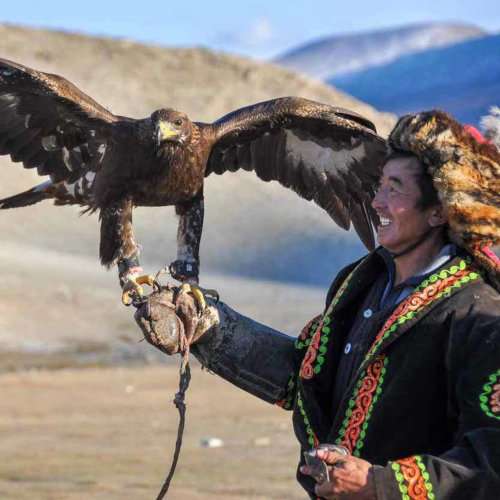
Gay rights in Mongolia
Gay rights in Mongolia are, well, more advanced than you'd expect. When compared to the rest of the continent, Mongolia is one of the more advanced gay nations in Asia. Mongolia repealed its anti-gay law back in 1993, introduced the right to change legal gender in 2009, and also passed hate crime laws to protect its LGBTQ community in 2017.
However, when you compare Mongolia to LGBTQ rights in Europe/North America, it is lagging behind quite a bit. For example, it still hasn't passed anti-discrimination laws to protect employees, has no laws to recognize gay couples, and in fact, has a constitutional ban against gay marriages.
Is Mongolia safe for gay travelers?
As gay tourists visiting Mongolia, we found it to be absolutely safe. We found Mongolians to be more fascinated by where we are from and about life in Europe. However, this is more down to the fact that as a foreigner you do get a sort of “pass” that the local LGBTQ community doesn't enjoy. We also were careful not to throw our relationship in people's faces – we don't express affection towards each other in public unless we know we are in a gay-friendly space.
When it came to booking accommodation, we never had any problems booking a double bed. The guesthouses and hotels we stayed in Ulaanbaatar were absolutely fine about this. Our tour guides knew we were gay but didn't bat an eyelid (though the “foreigner card” we mentioned above probably comes into play here).
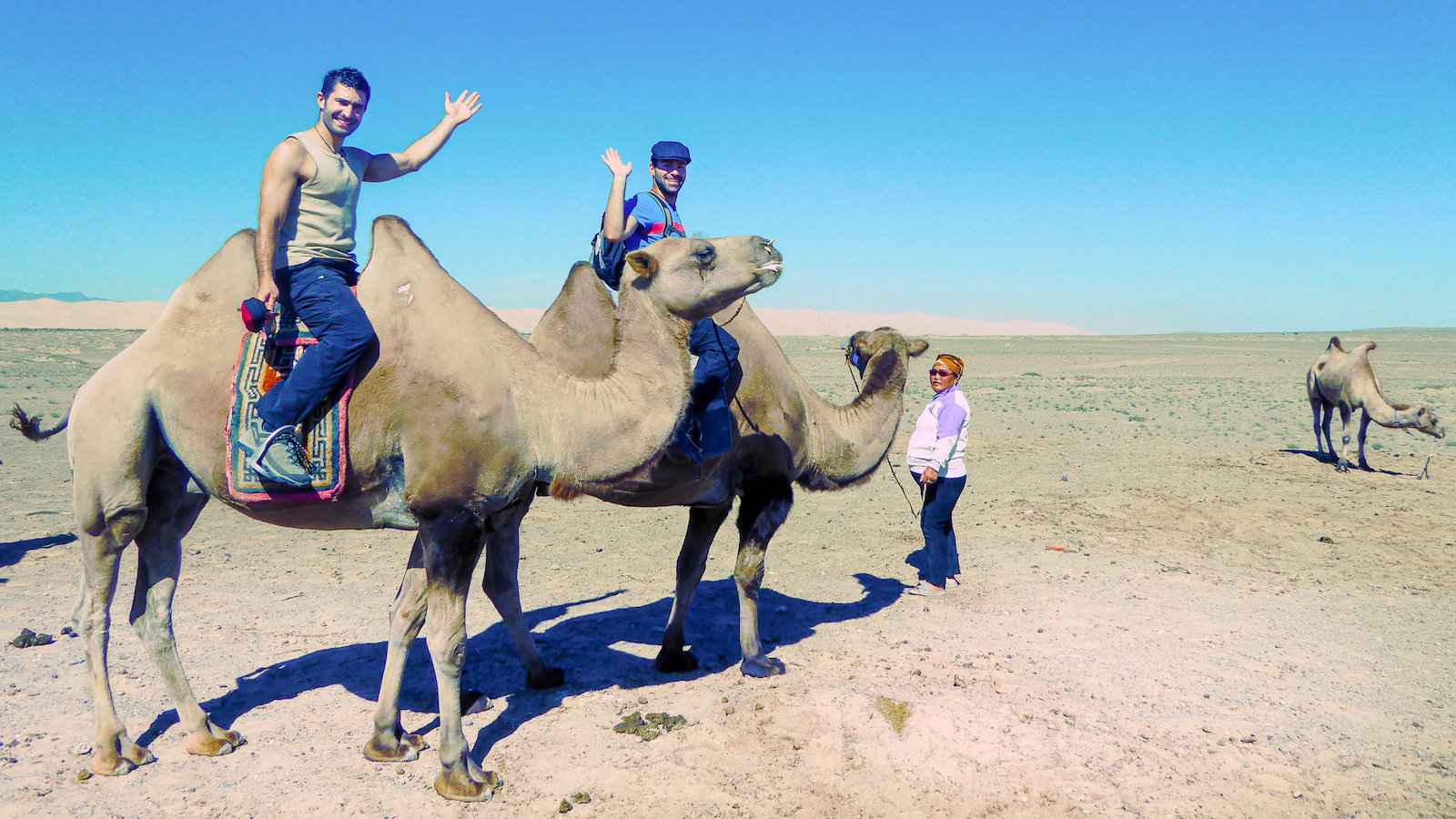
Gay tours in Mongolia
There are a small number of great gay tour companies offering group trips in Mongolia. We love doing these on our travels because sometimes it's just nice to relax and let someone else handle all the logistics. We always make plenty of new fabulous friends as well, so this is perfect if you're traveling solo.
1. Mongolia Golden Eagle Festival & Expedition
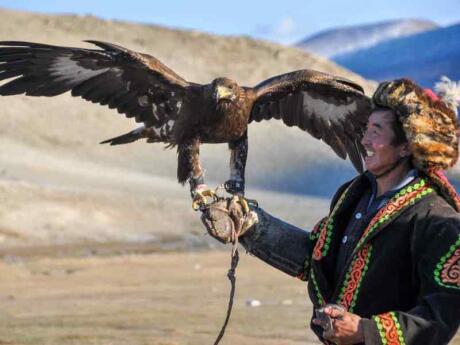
The Golden Eagle Festival is a once-in-a-lifetime experience, where you get to see Mongolian hunters with their majestic birds. This expedition by Out Adventures also includes time exploring the Gobi Desert by camel, horse-riding through the rugged landscape, sleeping in Gers with nomadic families and a private tour of Ulaanbaatar. Talk about a grand adventure!
2. Mongolia Gay Cultural Vistas Tour with He Travel
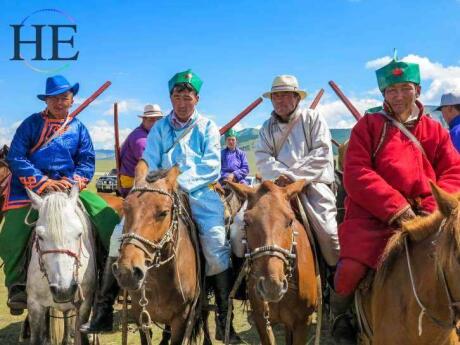
If you'd rather see the Naadam Festival than the Golden Eagle Festival then you'll love He Travel's Mongolia gay cultural vistas tour! Along with watching the archery, wrestling, and horse riding on display here, you'll also get to experience living with a nomadic family. This is an excellent way to see traditional life in Mongolia while also surrounded by other gay travelers.
HeTravel is offering our readers an exclusive 5% discount valid for any cruise and tour you book with them. Click the button below to find out more.
Top experiences in Mongolia for gay travelers
As a gay couple traveling in Mongolia, we were fully aware that we were not coming here to party or wear any exotic outfits at a Pride event! This is a country to visit to be amazed by the incredible nature, the unique landscapes, and the rich cultural nomadic lifestyle that dates back to the days of Genghis Khan.
We've set out below some of our favorite experiences that gay travelers should have at the top of their Mongolia Bucket List:
Watch a Mongolian drag show in Ulaanbaatar!
When we were in the capital, Ulaanbaatar, we stumbled on the country's sole gay bar. It has had several name changes over the years but has remained resilient against economic pressures, which you can read about in our interview with its owner Zorig about what it's like growing up gay in Mongolia. Today Zorig's bar is called the Melody Karaoke gay bar.
More recently, two other gay bars and clubs have opened in Ulaanbaatar. The first is DiEX, which hosts epic drag shows on Fridays and Saturdays. This is the most popular gay club in the country.
The second is the smaller C.U.M. gay bar, which hosts a drag show on Wednesday evenings.
Naadam Festival
This is like the Mongolian Olympics, except it happens every year – in July. Just like the Olympics, the Naadam Festival includes an incredible Opening Ceremony in Ulaanbaatar, with traditional dances, incredible outfits, speeches from prominent figures, and plenty of pomp and circumstance! The three main events are wrestling, archery, and horse riding, most of which take place in Ulaanbaatar with some events happening outside the capital. It really is a magnificent thing to see!
The Gobi Desert
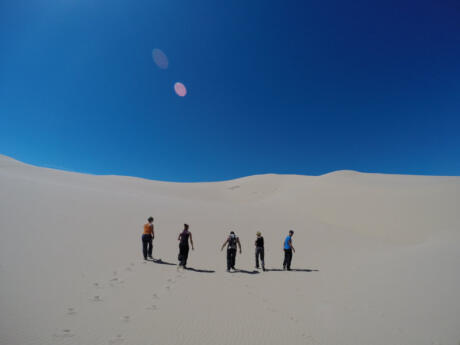
The Gobi Desert is the largest desert in Asia and the fifth-largest in the world. It was our favorite part of Mongolia – a truly remarkable range of landscapes comprising steppes, sands, and mountains. Some of it is so spectacular that it feels like you're walking on another planet – such as the Bayanzag flaming cliffs and the Tsagaan Suvarga mine. You can only visit on a tour, which also gives you the chance to stay overnight with Mongolian nomads in their gers (yurts).
Live like a Mongolian nomad
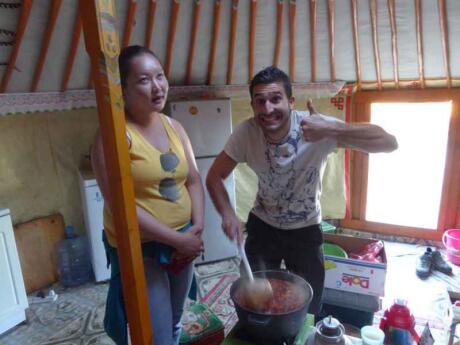
Most of the tours around Mongolia usually involve staying with Mongolian nomads in their gers (yurts). We cannot recommend this highlight enough. It's such a fascinating insight into how they live, what they eat, and their general culture, which dates back to the days of Genghis Khan. The nomadic lifestyle is humble but rewarding. It really made us appreciate nature more, along with basic human kindness – for example, the nomads have an unwritten rule of hospitality amongst themselves and welcome any traveler inside their ger.
See the wild horses in Khustai National Park
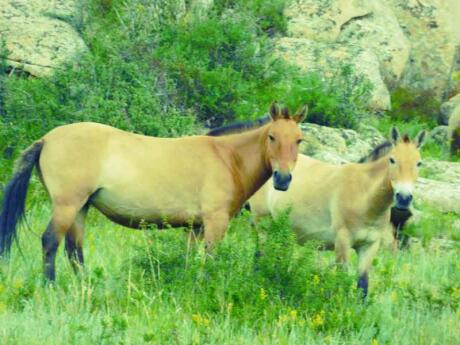
The Khustai National Park is a large conservation area in Central Mongolia, around 2/3 hours drive from Ulaanbaatar. It is particularly unique because it is home to the last remaining population of wild horses in Mongolia called Przewalski's Horse, or “takhi”, which translates to “worthy of worship” in Mongolian. They are more stocky compared to domesticated horses, with shorter legs. They are preserved in the Khustai National Park because they are so rare and critically endangered. So seeing them up close in the wild is quite an honor!
Horse riding in the Orkhon Valley
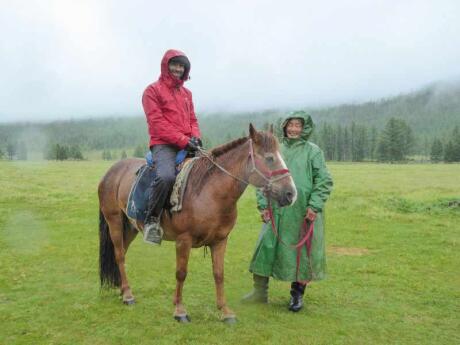
The Orkhon Valley is one of Mongolia's UNESCO-listed gems, largely due to the numerous archaeological remains dating back to the 6th century. It also includes “Kharkhorum” the former capital of Genghis Khan's massive Empire. The vast grassland area of the Orkhon Valley also comprises rivers and pretty waterfalls, making it a perfect living ground for nomadic families. We spent several nights in the Olkhon Valley staying with nomads and horse riding through this expansive region, visiting different nomadic family gers along the way.
Pride and other gay events in Mongolia
Mongolia is not known for being a gay party destination. If that's what you're after, better head to somewhere like Bangkok, Taipei, or Phuket. However, every August, the LGBTQ community of Ulaanbaatar has a Pride event called the “Equality Walk”. It includes a parade through the city's downtown area, a public concert, a film festival, and then finishing off at Zorig's gay bar (see above) for a fabulous party!
Gay travel agents in Mongolia
As well as the Golden Eagle Festival and Expedition tour we've already mentioned, Out Adventures also offer a fantastic bespoke travel service. Out Adventures is a wonderful gay travel company with a wealth of experience, so they can customize the perfect itinerary according to what you want to see and do in Mongolia. If you're tight on time and want someone to organize everything for you from start to finish, we highly recommend having a conversation with them asap!
Culinary highlights of Mongolia
Mongolian food is certainly, pretty unique! Without wishing to sound too harsh, this is not a destination famed for its gastronomy… Mongolia is a landlocked country with extreme seasons – harsh cold winters and very hot summers. This makes it super difficult to grow much. Therefore, the main staple food in Mongolia is animal meat (especially mutton), which can be reared easily. Everything else is imported from its giant neighbors, Russia or China. This is one place in the world that is definitely NOT vegetarian-friendly!
We've set out below the main traditional Mongolian foods you should try:
Airag

Sour and tangy… Airag is Mongolia's national beverage, so prominent across society that it carries a strong sense of national pride. Airag is fermented mare's milk with a slight alcoholic content of around 2%. It dates back to the Mongol times when it was a custom for nomadic families to offer any guests into their gers a bowl of freshly brewed airag. We were fortunate to be one of these guests on several occasions during our tours around Mongolia. But we'll be honest, we didn't quite take to airag… we'll let you form your own opinion!
Tsuivan

MUTTON! Mongolia is all about the mutton. Mutton for breakfast, mutton for luncheon, mutton for dinner. We're joking of course, but it felt like that during our tours here as almost every meal involved mutton meat! Called “tsuivan” locally, Mongolians eat all of the mutton including those chunky pieces of fat that we'd normally leave aside…as our guide put it – “we need it for strength and to stay warm during the harsh winter”.
Khuushuur
Khuushuurs are large fried meat dumplings, which reminded us of empanadas or Cornish pastries. The meat is usually mutton although beef can also be used. Other ingredients include onions, garlic, cumin, and sometimes cheese. Although eaten throughout the year, khuushuurs are particularly popular during the Nadam Festival in July, when street sellers sell them in droves around Ulaanbaatar. Our most prominent memory of the opening ceremony was the strong smell of deep-fried mutton, emanating from the freshly made khuushuurs that everyone around us was grazing on.
Buuz

Buuz are Mongolia steamed dumplings that contain minced meat, onion, garlic, and sometimes mashed potato, cabbage, or rice. Can you guess which meat is commonly used? Mutton! Although sometimes beef mince is also used. Buuz are eaten throughout the year but are particularly popular during the “Tsagaan Sar” Mongolian New Year celebrations in February. We found buzz and khuushuur to be quite similar – the main difference is that buuz are steamed whereas khuushuur are fried.
Khorkhog
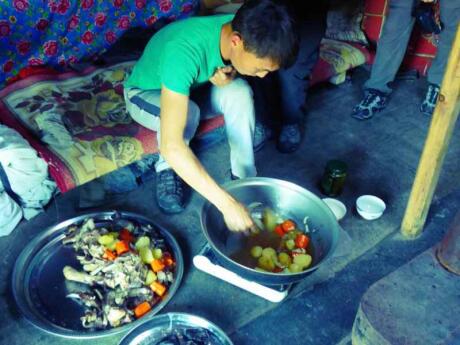
Now, THIS is one Mongolian feast that we'd happily have more of! A “khorkhog' (pronounced horhog – with a harsh h) is a Mongolian goat stew whereby the meat, potatoes, and vegetables are all cooked together in a deep large pan with hot stones for around 2 hours. We made a khorkhog with one of the nomadic families we stayed with. The end result was a delicious, succulent tasting dish with a rich broth. The broth is traditionally placed in a bowl and everyone takes it in turn to drink, then pass it around.
Plan your trip to Mongolia
We've put together some handy hints and tips to help you plan your own trip to Mongolia. Read on to find out everything the gay traveller should know before they go.
Travel insurance: We always ensure we've organized travel insurance before we go somewhere and definitely recommend you do the same before heading to Mongolia. We've been using Heymondo travel insurance for years and always had good experiences with them. They offer excellent cover so that you don't need to stress about lost luggage, illness or injury during your trip.
How to get there: Since Mongolia is a landlocked country, you'll most likely be arriving either by train or by air. International flights to Mongolia generally land at the Ulaanbaator International Airport, which is at least 30 minutes away from the city center. You can reach the city via public bus or taxi, although we usually pre-book a private transfer so we can just relax with the knowledge that our driver will be waiting no matter how late we arrive. This also means we don't need to juggle our luggage while figuring out public transport after a long flight.
Visa requirements: Mongolia grants visa-free access to citizens of 24 countries, (including the United States and Canada) for stays of up to 90 or 30 days. Some citizens can also get a visa on arrival, but make sure you check your own personal visa requirements before booking anything.
Getting around: Public transport isn't widespread in Mongolia outside of the cities so you'll mostly need to either join tour groups or hire a private driver if you want to explore further afield.
Vaccinations: It's recommended that all travelers to Mongolia have received routine vaccinations for things like measles, mumps, and chickenpox, along with vaccinations for hepatitis A, hepatitis B, rabies, and typhoid. Make sure you speak to your doctor and check the CDC website for more information before you make plans to visit.
Currency: The currency used in Mongolia is the Mongolian tögrög (or tugrik) which uses the currency code MNT and is often written as Tg. $1 (US) converts to around Tg 2,847, €1 is worth around Tg 3,361, and £1 converts to about Tg 3,916.
Tipping culture: Tipping is not generally expected anywhere in Mongolia, although it's becoming more accepted in places catering to westerners (like restaurants) and for tour guides. If you want to tip your guide a small amount you can but in other places it may be met with confusion.
Internet access: WiFi hotspots are available in the cities of Mongolia, along with a few internet cafes. Most hotels in Ulaanbaatar will also have WiFi but don't expect to be able to update your Facebook too often while off living with nomadic families on the plains! If you will need reliable internet for work then we recommend bringing a portable WiFi device with you.
Online privacy: There is some internet censorship in Mongolia, although it's mostly for curse words rather than gay dating apps, but we still recommend getting a VPN for your trip. This way everything you do online will be completely anonymous and secure, so there's no need to worry about your credit cards getting hacked or anything like that either.
Accommodation: We use Booking.com when organizing our accommodation in Ulaanbaatar and other parts of Mongolia, as they have the best prices and often offer free cancellation which is perfect if you like to be spontaneous. Their online customer service is excellent and available 24/7 as well.
Sightseeing and adventure: When looking for fun activities and tours in Mongolia we always turn to GetYourGuide! They have so many exciting options plus it's really easy to book online. They also provide wonderful online support that's available 24/7.
When to visit: Summer, between June and August, is definitely the nicest time to visit Mongolia, as it's warm but only hot in the desert. Spring and autumn can be unpredictable in terms of weather (but still worth going) and while winter sees the least amount of tourists, temperatures can also reach -30 degrees!
Safety tips for gay travelers to Mongolia
Is Mongolia safe for gay travelers? The short answer is yes, but make sure you avoid PDAs unless you're in a gay establishment.
- Check official government advice before you go. We recommend you do this any time you're traveling so that you are aware of any recent developments that might create difficulties. This is the most recent travel advice for UK citizens to Mongolia, but check your own government website if you're traveling from somewhere else.
- Although homosexuality is legal in Mongolia, you should avoid public displays of affection unless you're in an actual gay bar or club. We didn't encounter any problems during our time in Mongolia, but we also didn't flaunt our sexuality either.
- Just like anywhere in the world, be aware of your surroundings, especially in big cities. Petty crime is prevalent in the capital of Ulaanbaatar, but if you're alert to your surroundings then you should be fine.
- Avoid excess alcohol and drug use. Be careful not to drink too much when in a new country, as you're a much easier target when obviously intoxicated.
- Don't wear valuables in public. This is basic common sense. Whilst we felt very safe in Mongolia, pickpockets operate everywhere in the cities, so the more bling you show off, the more alluring you become as a target. We recommend leaving your valuables and important items locked away in your hotel safe!
- Invest in a good money belt. It's always better not to carry too much cash or credit cards anyway, but having a good money belt hidden under your clothes is one of the best ways we've found of ensuring your valuables stay safe and secure out of harm's reach.
Read more travel adventures like this in our book!
We've published our very own gay travel book called, ‘Out in the World'. It has all our practical safety tips, first-hand advice, and travel stories from some of our favorite destinations.
We hope it inspires you to have a fun and safe trip!
Click on the book to order:

For more inspiration:
- Read these interesting facts about Mongolia you might not have known
- Make sure you check out our video of the best moments in Mongolia we experienced
- Use our gay China travel guide if you're heading there next
- See the Terracotta Army with our gay guide to Xi'an
- Don't miss our gay travel guide to Tokyo if you're going to Japan
- Along with the best gay hotels in Tokyo you'll want to stay at
- Find out why it's called “the Land of Smiles” in our gay guide to Thailand
